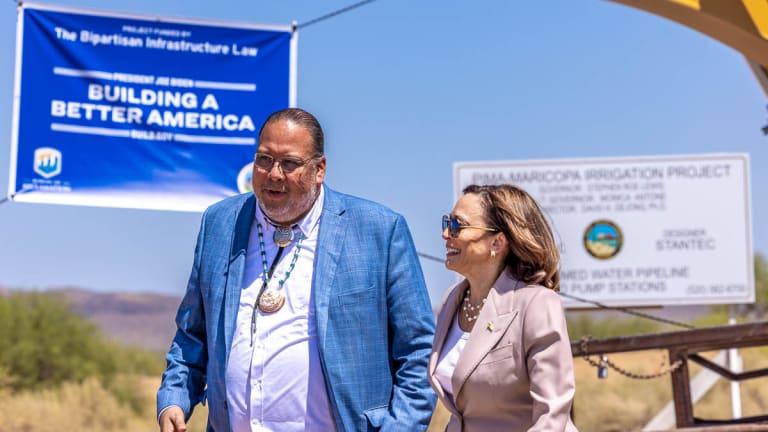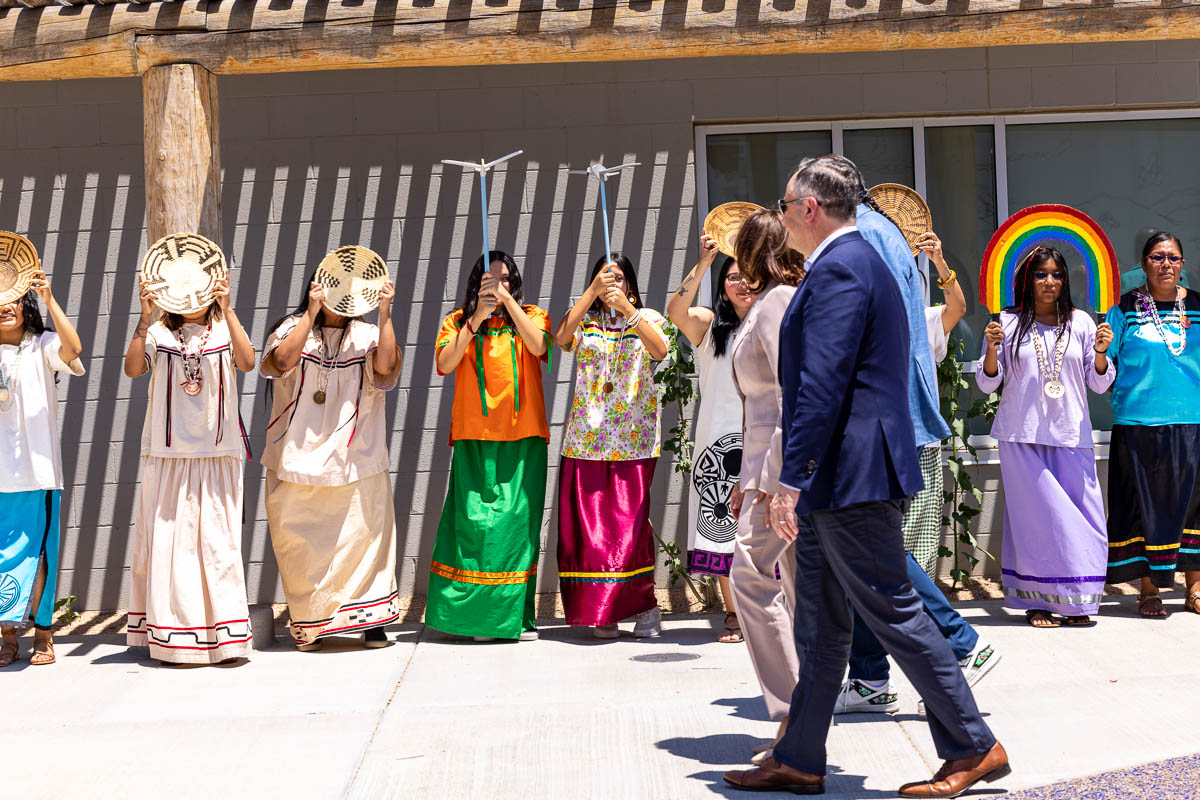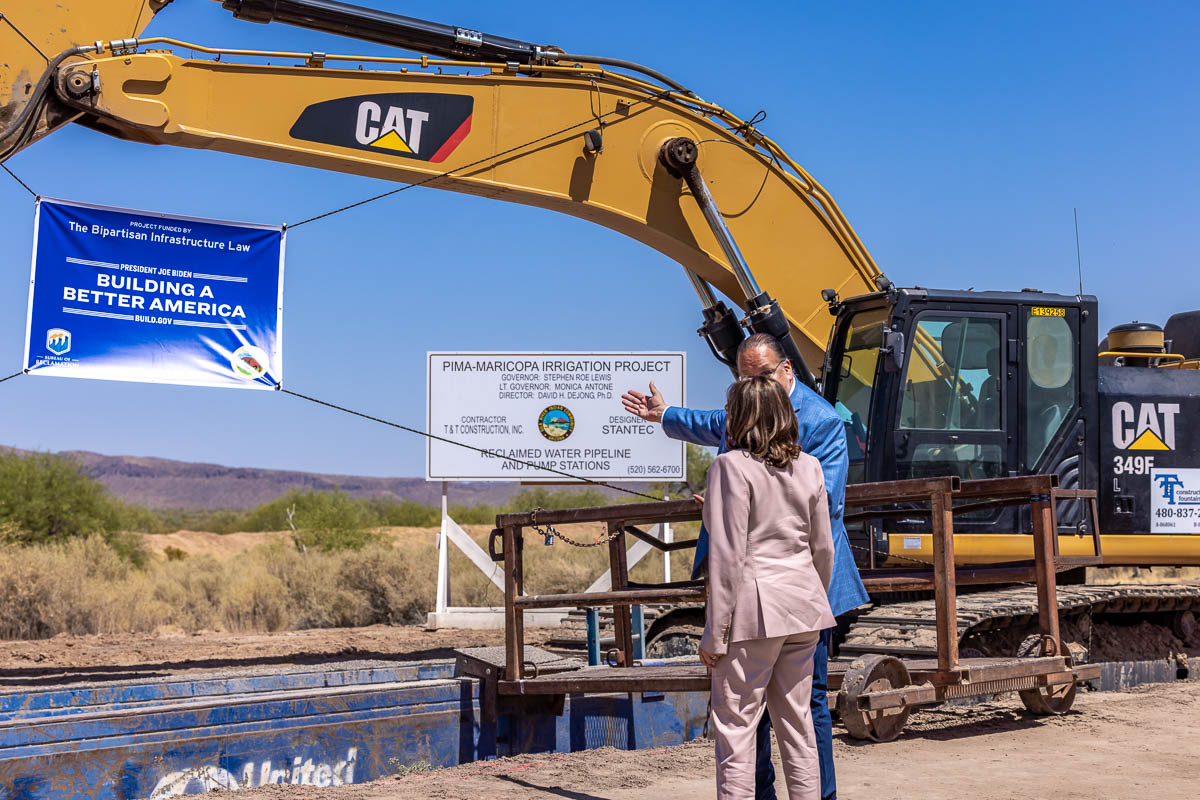In an exclusive interview with the ICT Newscast, the vice president spoke about an array of issues from missing and murdered, to judicial appointments

Vice President Kamala Harris visits the Gila River Indian Community in Arizona on July 6, 2023. (Photo by Kyle Knox, Gila River Indian News)
JOURDAN BENNETT-BEGAYE AND NIKA BARTOO-SMITH
JUL 10, 2023
ICT and Underscore
“Madam Vice President, welcome to the ICT Newscast.”
History made in one opening line from ICT’s Newscast Anchor Aliyah Chavez, Kewa Pueblo, when she welcomed Vice President Kamala Harris onto the ancestral lands of the Akimel O’odham and Piipaash peoples on the Gila River Indian Reservation, south of Phoenix, on July 6.
Vice President Harris’ visit in the Gila River Indian Community marks the first visit from a sitting president or vice president for the Indigenous nation. Past presidents and vice presidents have previously visited other Indigenous nations across the country.
The vice president made the trip to Gila River, with an invite from Gov. Stephe Roe Lewis, as part of the Investing in America Tour. Addressing the crowd at the Gila Crossing Community School south of Phoenix, the vice president highlighted the Biden-Harris Administration’s recent investments in tribal nations, particularly those to address the climate crisis and support Native-owned small businesses.
(Related: Kamala Harris discusses historic Gila River trip)
“In order to create enduring solutions to the climate crisis, we must then rely on the knowledge and the experience of Native communities,” Harris said during her visit to the Gila River Indian Community. “And that is why we are investing billions of dollars to help fund Native-led — not Native-consulted — Native-led, climate-resilient infrastructure projects.”
JUL 10, 2023
ICT and Underscore
“Madam Vice President, welcome to the ICT Newscast.”
History made in one opening line from ICT’s Newscast Anchor Aliyah Chavez, Kewa Pueblo, when she welcomed Vice President Kamala Harris onto the ancestral lands of the Akimel O’odham and Piipaash peoples on the Gila River Indian Reservation, south of Phoenix, on July 6.
Vice President Harris’ visit in the Gila River Indian Community marks the first visit from a sitting president or vice president for the Indigenous nation. Past presidents and vice presidents have previously visited other Indigenous nations across the country.
The vice president made the trip to Gila River, with an invite from Gov. Stephe Roe Lewis, as part of the Investing in America Tour. Addressing the crowd at the Gila Crossing Community School south of Phoenix, the vice president highlighted the Biden-Harris Administration’s recent investments in tribal nations, particularly those to address the climate crisis and support Native-owned small businesses.
(Related: Kamala Harris discusses historic Gila River trip)
“In order to create enduring solutions to the climate crisis, we must then rely on the knowledge and the experience of Native communities,” Harris said during her visit to the Gila River Indian Community. “And that is why we are investing billions of dollars to help fund Native-led — not Native-consulted — Native-led, climate-resilient infrastructure projects.”

Vice President Kamala Harris visits the Gila River Indian Community in Arizona on July 6, 2023. (Photo by Kyle Knox, Gila River Indian News)

Vice President Kamala Harris visits the Gila River Indian Community in Arizona on July 6, 2023. (Photo by Kyle Knox, Gila River Indian News)
The Reclaimed Water Pipeline Project is one such project. After meeting with young Native leaders and delivering remarks of her own, Vice President Harris listened to a briefing on the Gila River Indian Community’s Reclaimed Water Pipeline Project. Aimed at ensuring reliable access to clean water, the project also will help reduce dependence on the Colorado River, which continues to be strained after more than two decades of drought. The pipeline will transport water over a 19-mile span, drawing from sustainable sources such as reclaimed water pumped from recharged groundwater, according to a press release.
Funded in part by $83 million from the Bipartisan Infrastructure Law, White House Infrastructure Coordinator Mitch Landrieu announced the pipeline project in April 2023. Construction began in May 2023 and the pipeline is scheduled for completion by the end of 2024.
During her remarks at the Gila River Community School, Vice President Harris also briefly addressed the crisis of missing and murdered Indigenous relatives.
“We must continue to fight to address the urgent crisis of missing and murdered Indigenous people. I feel very strongly about that,” she said.
On air during the ICT newscast, Chavez asked the vice president about what it means to provide relief to Indigenous families with missing or murdered loved ones.
“It is absolutely tragic that we have so many people who have gone missing or have been murdered and that there has not been a response that is nationwide to understand what is happening and why,” Vice President Harris said during the newscast. “We must all stand up and say that this is not right and let's put the resources into it.”
The vice president pointed to a few actions taken by the Biden-Harris Administration to begin to address the crisis. These include the Executive Order on Improving Public Safety and Criminal Justice for Native Americans and Addressing the Crisis of Missing and Murdered Indigenous People signed by President Biden in November 2021 and the Missing and Murdered Unit within the Bureau of Indian Affairs Office of Justice Services created by Interior Secretary Deb Haaland in April 2021.
“We are gonna continue to work on it,” Vice President Harris said during the newscast. “We are putting in the resources to do something about it.”
There have been many appointments of Indigenous peoples in the Biden-Harris administration. Many are the first, such as the first Native person to be in the cabinet, Interior Secretary Haaland, who is Laguna Pueblo, to Shelly Lowe, Navajo, as the chair of the National Endowment for the Humanities, who is the first to serve in that position. Another is Chief Lynn Malerba, appointed as the Treasurer of the United States. Malerba is chief of the Mohegan Tribe. The administration also has established new offices and long-standing positions, such as the director of the U.S. Department of Treasury of tribal and Native affairs. Fatima Abbas, Haliwa Saponi, fills that role.

Vice President Kamala Harris visits the Gila River Indian Community in Arizona on July 6, 2023. (Photo by Kyle Knox, Gila River Indian News)
Bringing Native people into these positions is about partnership and “setting a new model” for the nation-to-nation collaboration.
“The president and I feel very strongly that we should not be burdened by things the way they've always been. We should be looking to what should be,” Harris told ICT. That representation “should happen” and “that's the work that we are doing, the work that we are doing in partnership with Indian Country.”
As for the judicial appointments, Harris wasn’t allowed to speak on specific names. However, she and the president are “closely monitoring what must happen to ensure that the federal bench reflects the faces and the names and the numbers of all people in our country. And we are very proud of what we have done to accelerate representation on the federal courts.”
There have been only six Native people to serve as Article III judges out of 673 federal district court judges and 4,200 people who served as Article III judges in the 230-plus year history of the U.S. courts.
ACTIVE: Sunshine Suzanna Sykes, first Navajo Nation citizen to be an Article III judge in the nation. She serves as a federal judge in California, the first Indigenous person to do so.
ACTIVE: Lauren King, from Muscogee Nation, was confirmed as a federal judge in October 2021 in Washington state, the first in the state’s history.
ACTIVE: Ada Brown, Choctaw, is the judge of the U.S. District Court for the Northern District of Texas.
ACTIVE: Lydia Kay Griggsby, was confirmed in June 2021 as the judge on the United States District Court for the District of Maryland.
ACTIVE: Diane Humetewa, Hopi, became the first Native woman to serve as a federal judge in 2014.
Michael Burrage, Choctaw, was the first Native American federal judge in 1994.
Biden nominated three during his time: Sykes, King, and Griggsby.
A few judges cited by the Federal Judicial Center do not have demonstrable ties to tribal communities or enrollment. For example, some say Frank Howell Seay was the first Native federal judge who is now retired. President Jimmy Carter nominated him in 1979. He learned of his Indigenous ties long after he was nominated. He is not enrolled in Cherokee Nation, the nation’s tribal registration office told ICT.

BY JOURDAN BENNETT-BEGAYE
Jourdan Bennett-Begaye, Diné, is editor of ICT and based in its Washington bureau. She is the first woman to be the chief news executive and top editor of the 40-year-old newspaper and website. Bennett-Begaye’s Grey’s Anatomy obsession started while attending the S.I. Newhouse School of Public Communications. Follow her on Twitter: @jourdanbb or email her at jourdan@ictnews.org. Support ICT for as little as $10.
Follow @jourdanbb

BY NIKA BARTOO-SMITH
Nika Bartoo-Smith is a reporter at Underscore + ICT. Follow her on Twitter: @BartooNika. An Osage and Oneida Nations descendent, Bartoo-Smith is based in Portland, Oregon.
No comments:
Post a Comment